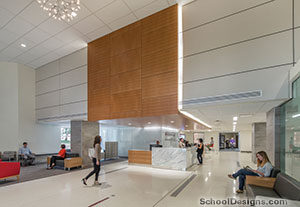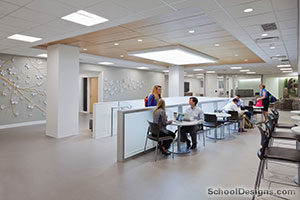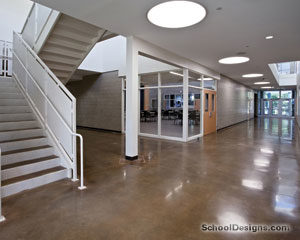Columbus City Schools, Columbus Scioto 6-12 School
Columbus, Ohio
The Columbus Scioto 6-12 School was designed to unite an existing middle school and high school for emotionally disturbed students in the Columbus City Schools District. The 73,000-square-foot LEED Gold facility was designed to create an atmosphere of educational stimulation while providing a calming environment for the student population, who cope with challenges such as autism and anger management. Through therapy, education, and recreation, the school and site provide both the students and adults with a failure-free environment to achieve holistic learning and healing and to interact in a calming way.
The overall impression sought for the exterior of the building was "nested boxes within a prairie." The base of the building is earth-toned brick, while the upper level nested boxes and roofs are light blue metal panels. Colors were selected to create a sense of grounding to the earth and a sense of peace in the minds of the students. Program elements are organized though three key planning strategies: 1) An entry and circulation spine or “Main Street”; 2) A collection of villages with the Academic Village to the east and the Wellness and Arts Village to the west; 3) The “Town Square” location of the cafeteria and the media center. The Main Street spine provides a clear sense of entry and way finding, connecting all of the diverse program elements. Clear lines of site into each area of the building were critical to achieving proper security and all corridors end with a transparent wall. Appropriately sized and located windows, clerestories, and roof monitors in the corridors and classrooms are used throughout the building to allow for views to nature and the sky and to create a sense of openness and transparency. Strategically located interior glazing continues to foster a sense of connection among different parts of the building, such as Main Street, the cafeteria and the media center.
At the site scale, early discovery of archaeologically significant burials from a prehistoric Late Woodland village required the establishment of an archaeological limit line to preserve a portion of the nine-acre site. The design team creatively addressed this reduced site area challenge by layering the sustainable site systems and building. The multi-purpose fields and sensory garden, which are utilized by the students and staff to aid in emotional de-escalation, sit above the zero-discharge stormwater system, which is the first of its kind in the city of Columbus. Underneath the zero-discharge stormwater system is the geothermal well field, which feeds the geothermal heat pump system inside the building.
Additional Information
Capacity
250
Cost per Sq Ft
$185.00
Featured in
2014 Architectural Portfolio
Other projects from this professional

Bowling Green State University, Moseley Hall Renovation
Moseley Hall is a historic 1913 building in the Traditions Quad at...

The Ohio State University, Wexner Medical Center, Brain and Spine Hospital
Associated firms: Perkins + Will (Neuro Planning Consultant), Korda/Nemeth Engineering (Mechanical, Fire...

Ohio University, Heritage College of Osteopathic Medicine Northeast Campus
Associated firms: Perspectus Architecture (Associate Architect), Karpinski Engineering (Mechanical, Electrical, Technology Engineer),...

Columbus City Schools, Columbus Scioto 6-12 School
The Columbus Scioto 6-12 School was designed to unite two existing schools...
Load more


